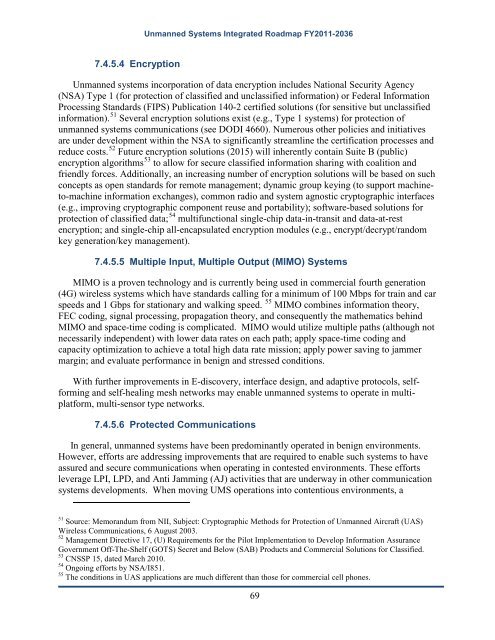Unmanned Systems Integrated Roadmap FY2011-2036 - Defense ...
Unmanned Systems Integrated Roadmap FY2011-2036 - Defense ...
Unmanned Systems Integrated Roadmap FY2011-2036 - Defense ...
You also want an ePaper? Increase the reach of your titles
YUMPU automatically turns print PDFs into web optimized ePapers that Google loves.
7.4.5.4 Encryption<br />
<strong>Unmanned</strong> <strong>Systems</strong> <strong>Integrated</strong> <strong>Roadmap</strong> <strong>FY2011</strong>-<strong>2036</strong><br />
<strong>Unmanned</strong> systems incorporation of data encryption includes National Security Agency<br />
(NSA) Type 1 (for protection of classified and unclassified information) or Federal Information<br />
Processing Standards (FIPS) Publication 140-2 certified solutions (for sensitive but unclassified<br />
information). 51 Several encryption solutions exist (e.g., Type 1 systems) for protection of<br />
unmanned systems communications (see DODI 4660). Numerous other policies and initiatives<br />
are under development within the NSA to significantly streamline the certification processes and<br />
reduce costs. 52 Future encryption solutions (2015) will inherently contain Suite B (public)<br />
encryption algorithms 53 to allow for secure classified information sharing with coalition and<br />
friendly forces. Additionally, an increasing number of encryption solutions will be based on such<br />
concepts as open standards for remote management; dynamic group keying (to support machineto-machine<br />
information exchanges), common radio and system agnostic cryptographic interfaces<br />
(e.g., improving cryptographic component reuse and portability); software-based solutions for<br />
protection of classified data; 54<br />
multifunctional single-chip data-in-transit and data-at-rest<br />
encryption; and single-chip all-encapsulated encryption modules (e.g., encrypt/decrypt/random<br />
key generation/key management).<br />
7.4.5.5 Multiple Input, Multiple Output (MIMO) <strong>Systems</strong><br />
MIMO is a proven technology and is currently being used in commercial fourth generation<br />
(4G) wireless systems which have standards calling for a minimum of 100 Mbps for train and car<br />
speeds and 1 Gbps for stationary and walking speed. 55<br />
MIMO combines information theory,<br />
FEC coding, signal processing, propagation theory, and consequently the mathematics behind<br />
MIMO and space-time coding is complicated. MIMO would utilize multiple paths (although not<br />
necessarily independent) with lower data rates on each path; apply space-time coding and<br />
capacity optimization to achieve a total high data rate mission; apply power saving to jammer<br />
margin; and evaluate performance in benign and stressed conditions.<br />
With further improvements in E-discovery, interface design, and adaptive protocols, selfforming<br />
and self-healing mesh networks may enable unmanned systems to operate in multiplatform,<br />
multi-sensor type networks.<br />
7.4.5.6 Protected Communications<br />
In general, unmanned systems have been predominantly operated in benign environments.<br />
However, efforts are addressing improvements that are required to enable such systems to have<br />
assured and secure communications when operating in contested environments. These efforts<br />
leverage LPI, LPD, and Anti Jamming (AJ) activities that are underway in other communication<br />
systems developments. When moving UMS operations into contentious environments, a<br />
51<br />
Source: Memorandum from NII, Subject: Cryptographic Methods for Protection of <strong>Unmanned</strong> Aircraft (UAS)<br />
Wireless Communications, 6 August 2003.<br />
52<br />
Management Directive 17, (U) Requirements for the Pilot Implementation to Develop Information Assurance<br />
Government Off-The-Shelf (GOTS) Secret and Below (SAB) Products and Commercial Solutions for Classified.<br />
53<br />
CNSSP 15, dated March 2010.<br />
54<br />
Ongoing efforts by NSA/I851.<br />
55<br />
The conditions in UAS applications are much different than those for commercial cell phones.<br />
69

















